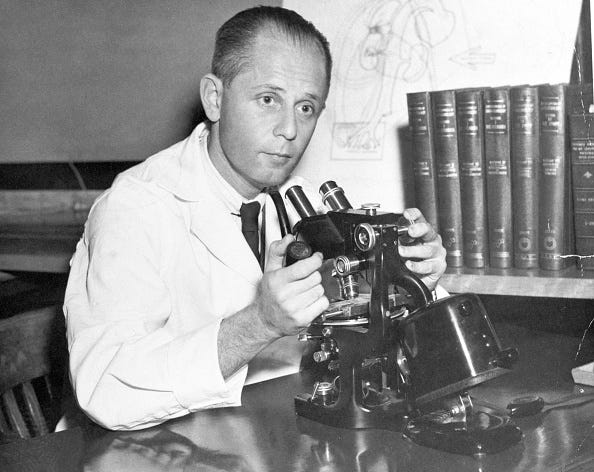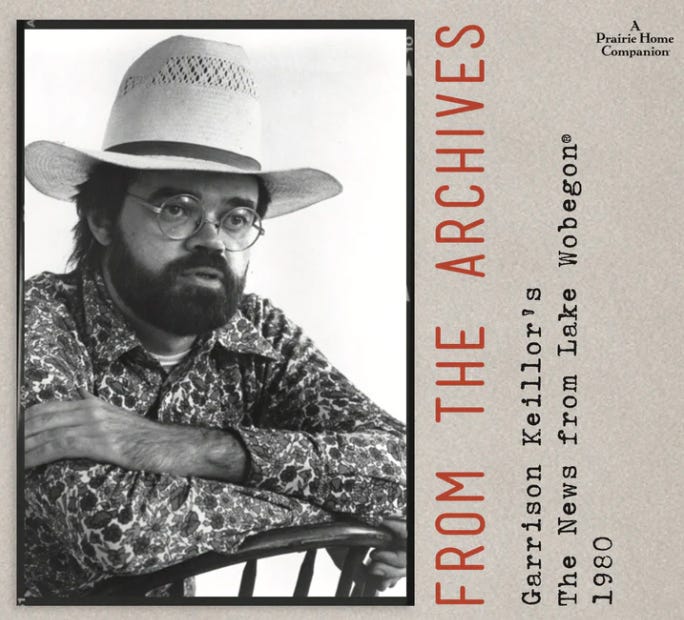“Subway Psalm” by Alden Nowlan from What Happened When He Went to the Store for Bread. © The Thousands Press, 2000.
ORIGINAL TEXT AND AUDIO - 2017
It's the birthday of Hungarian endocrinologist Hans Selye, born in Vienna, Austria-Hungary (1907). When his discovery came about, Selye was just another bright 28-year-old assistant in the Biochemistry Department at McGill University, conducting tests on rats. Specifically, he was injecting rats with extracts of various organs. When he used ovarian extract, the rats developed certain symptoms, including bleeding ulcers and enlarged adrenal cortexes. Selye was thrilled, convinced that he had discovered a new ovarian hormone. But the same thing happened when he introduced extract from the placenta, and then various other organs, and finally the extract of a toxic liquid — so he knew it couldn't be a hormone, which would be produced by a specific part of the body. He was totally confused. He said, "I became so depressed that for a few days I just sat in my laboratory, brooding about how this misadventure might have been avoided and wondering what was to be done now."
Selye reflected back on his days as a 19-year-old medical student at the University of Prague. He had been surprised that so many patients exhibited similar, general symptoms — loss of appetite, aches, rashes, or fevers — before they were eventually diagnosed with specific diseases. He was intrigued by what he called "the syndrome of just being sick." He explained this to his advisor, who laughed it off. Selye said: "Since these were my first patients, I was still capable of looking at them without being biased by current medical thought. Had I known more, I would never have asked myself questions."
Ten years later, in the lab at McGill, he did know more; but as he thought about those patients and their symptoms from "just being sick," he wondered whether this was similar to what he observed in the rats. He also thought about how there were certain general things that doctors prescribed, like rest and eating well, that helped with a wide variety of diseases. He guessed that the body had some general response to "noxious agents" placed on it, and that all illnesses caused the body to issue this general response. He called this theory the "General Adaptation Syndrome," and published his findings in 1936 in the journal Nature.
Selye chose the word "stress" to describe the general bodily responses to noxious agents. He was eventually fluent in eight languages and proficient in several more. But at the time he chose the word "stress," he wasn't quite fluent in English. He didn't understand the use of the word "stress" in physics, where "stress" is the force on an object per unit area, whereas "strain" is the measurement of how an object responds to stress. For years afterward, Selye said that if only he had understood the complexities of English better, he would have chosen the word "strain" instead of "stress." But by that time it was too late, and the word "stress" was adopted not just in English but in many other languages as well; because there was no appropriate translation, other languages just used the English word "stress." Selye devoted the rest of his life to studying stress and its effects on the human body. He usually worked 10 to 14 hours a day, every day, including weekends and holidays. He wrote several books, including The Stress of Life (1956) and Stress without Distress (1974).
Selye said: "The element of chance in basic research is overrated. Chance is a lady who smiles only upon those few who know how to make her smile."
And: "Find your own stress level — the speed at which you can run toward your own goal. Make sure that both the stress level and the goal are really your own, and not imposed upon you by society, for only you yourself can know what you want and how fast you can accomplish it. There is no point in forcing a turtle to run like a racehorse or in preventing a racehorse from running faster than a turtle because of some 'moral obligation.' The same is true of people."
It's the birthday of children's book author and editor Mary Mapes Dodge, born Mary Mapes in New York City (1831). She was born into a prestigious New York family. Her father was an inventor and an entrepreneur who planned to revolutionize the farming industry with new chemical fertilizers. One of the investors in his fertilizer idea was a man named William Dodge, who later married young Mary Mapes.
Mary Mapes Dodge lived with her husband in New York City for five years, and had two sons. Then one night in 1858, her husband left the house and never came back. It turned out that he had drowned — possibly a suicide. She was devastated and took her sons to live on her father's farm. She moved into a room in the attic, which she decorated with moss, leaves, flowers, and a painting of the Rhine River on the ceiling. She spent many hours in the attic playing with her sons and telling them stories, and eventually she began to write down the stories and submit them to magazines.
She had long been interested in writing something about Holland, although she'd never been there. She had some Dutch friends who had emigrated from Amsterdam, and she asked them to tell her everything they knew about their home country, what things looked like and smelled like, and the things people did and the food they ate and the stories they told their children at night. She used all of these details to write a children's book called Hans Brinker; or, The Silver Skates (1865), which became a best-seller. In the 15 years after it was published, it received more reviews than any other children's book in America.
The historical background of Holland that Mary Mapes Dodge wrote about in Hans Brinker; or, The Silver Skates (1865) included a story about a boy who saved Holland by sticking his finger in a dike. That story was her own invention, but it became so famous that many people believed it was an old Dutch folktale.
In 1872, Charles Scribner and two of his partners were thinking of developing a magazine for children, and they wrote to Dodge to ask for her advice. She replied: "The child's magazine, needs to be stronger, truer, bolder, more uncompromising than the [adult's]. ... Let there be no sermonizing either, no wearisome spinning out of facts, no rattling of the dry bones of history. A child's magazine is its pleasure ground."
They were impressed enough by her response that they asked her to edit the children's magazine, which became known as St. Nicholas. Dodge chose the name, because she said: "Is he not the boys' and girls' own Saint, the especial friend of young Americans? That he is. ... And, what is more, isn't he the kindest, best, and jolliest old dear that ever was known? Certainly again."
St. Nicholas became one of the most successful children's publications of all time. It included work by writers such as Louisa May Alcott, Henry Wadsworth Longfellow, John Greenleaf Whittier, Alfred Tennyson, Rudyard Kipling, and Mark Twain. The magazine also encouraged young people to submit stories and poems for publication. Among the writers who first published their work in St. Nicholas were Ring Lardner, Edna St. Vincent Millay, Eudora Welty, Edmund Wilson, and F. Scott Fitzgerald.
It's the birthday of Irish statesman, co-founder of Amnesty International, and winner of the 1974 Nobel Peace Prize, Seán MacBride, born in Paris (1904). He's the son of Maud Gonne, the woman whom poet W.B. Yeats worshipped and embraced as his Muse. Sean's father was Major John MacBride, a military leader whom Gonne chose to marry over Yeats and whom Yeats considered a "brute." John MacBride and Maud Gonne separated when their son was a child, and Sean grew up in Paris with his mother, speaking French as a first language. He was still in France, age 12, when his father was executed for helping to lead the Easter Rising, the 1916 rebellion where Irish nationalists took over government buildings in an effort to force the end British rule of Ireland.
But not long after the Easter Rising, Sean MacBride headed to Ireland, joined the IRA, and fought in the Irish War of Independence from Britain. Then he was imprisoned by the new Irish Free State's government during the Irish Civil War that followed, because he was opposed to the terms of the Anglo-Irish treaty, which had come at the end of the war. When Sean MacBride got out of jail, he went to law school.
He worked as a lawyer for human rights cases around the world, investigating abuses by governments against civilians, especially ones that happened in times of war. He was one of the founders of the human rights group Amnesty International, and held several United Nations posts throughout his life, including Assistant Secretary-General and President of the General Assembly. He was awarded the Nobel Peace Prize in 1974 (exactly 10 years after Martin Luther King Jr.) for mobilizing "the conscience of the world in the fight against injustice." About a year after that, he was given the Lenin Peace Prize, making him at the time the only person in the world to get both Nobel and Lenin Peace Prizes.
Be well, do good work, and keep in touch.®






What's happened to the WA that has stopped coming to my email? Nothing so far in February! What's Up?
It isn't clear what Hans Selye did.